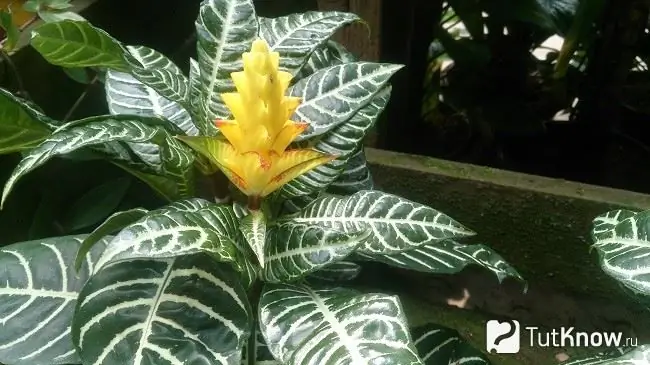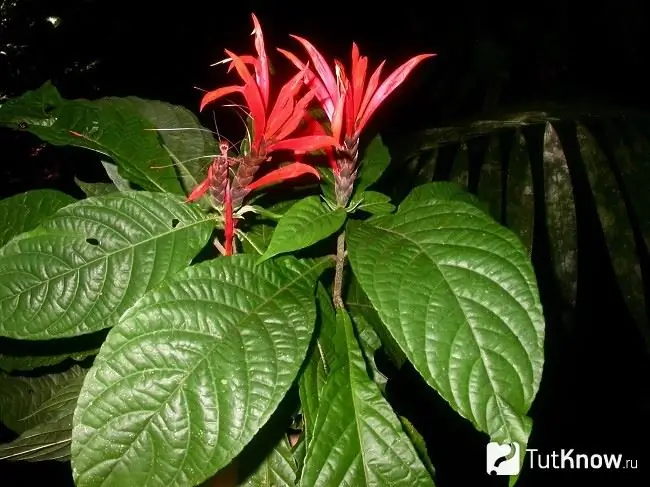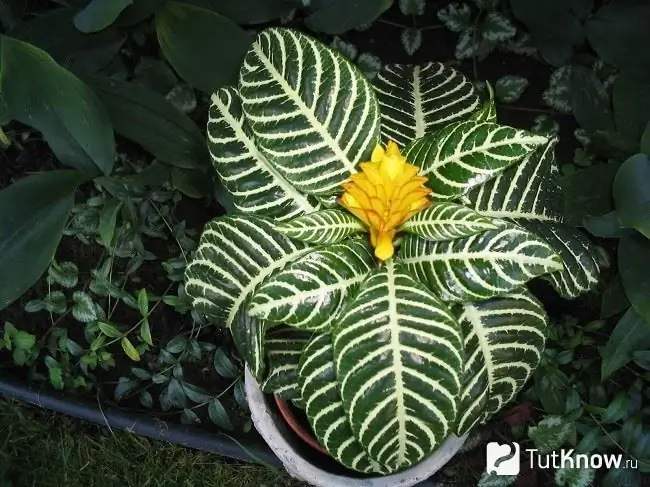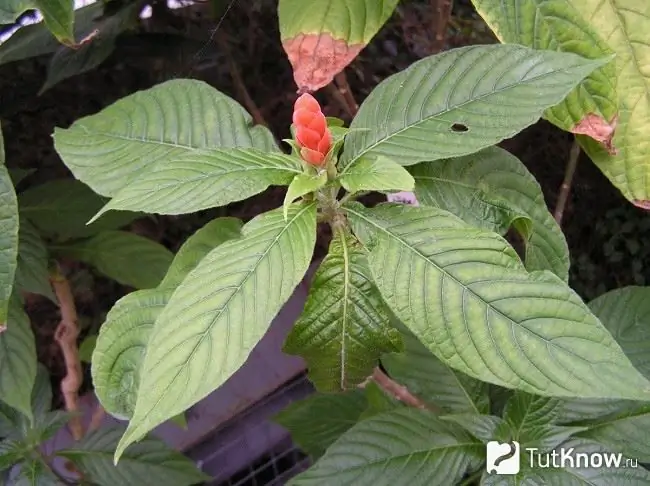- Author Arianna Cook [email protected].
- Public 2024-01-12 17:55.
- Last modified 2025-01-23 09:40.
The origin of the Afelandra, the known varieties, a description of the features, advice on growing and caring for the flower, possible difficulties and methods of their elimination. A graceful sonorous name and a mesmerizing appearance are the qualities characteristic of Afelandra. This plant will serve as a very appropriate exhibit for your interior, which will delight you every day with its beauty and originality. We can say with confidence that this flower will be able to attract the attention of even the most indifferent to the world of plants of a person.
Homeland and origin of Afelandra

Afelandra (lat. Aphelandra) - the beginning of the history of a kind, this plant takes from the Acanthaceae family. In the wild, it is a representative of long-term herbaceous plants that can grow in the form of shrubs and semi-shrubs. The homeland of a beautiful perennial is tropical or subtropical territories of South and Central America.
Varieties of Afelandra

The variety of Afelandra species is quite large. All over the world there are about 40-140 species of this flower, but, unfortunately, not all of them exist in our time and few of them can be found in a flower shop or in the house of your friends. We present to your attention those representatives of this interesting genus, which are the most demanded and popular today:
- Aphelandra bulging (lat. Aphelandra squarrosa). She honors sunny Brazil as her homeland. It is this flower that is most popular and in demand among avid florists and amateur florists. The reason for this is its natural unpretentiousness to the conditions of the home environment, despite its tropical origin. In the wild, it occurs under the guise of a rather large shrub that grows up to 50-60 cm in height. It has beautiful leaves, which are egg-shaped and rather large (the length of one leaf can reach about 25-30 cm), they are painted in a rich dark green color. On the surface of the sheet, one cannot fail to notice an excellent ornament of white-silver color. Leaves originate from juicy, uncovered shoots. The stems of the plant are reddish. The most attractive part of the plant is the inflorescences, which have the shape of a quadrangular spike, they are formed from small pale yellow flowers in addition to bright orange bracts. The period during which you can admire the beautiful flowers is quite long (subject to suitable temperature conditions).
- Aphelandra golden or orange aphelandra (lat. Aphelandra aurantiaca). The homeland of this species is Mexico. It has a shrub growth. Its peculiarity is that, with a relatively small growth, it has rather large beautiful leaves, elliptical or ovoid in shape with solid edges and a pointed tip, which are painted in a special green color with a silvery sheen. The stem is slightly reddish in color and tends to lignify. During the flowering period, you can contemplate the terminal inflorescence, which has the shape of a tetrahedral spike, which in its composition has bright orange flowers with light green bracts. The corolla is two-lipped, the upper lip is two-lobed, and the lower one is three-lobed. Flowering lasts about 5-7 days.
- Afelandra Retzl (lat. Aphelandra aurantiaca var. Roezlii). We can say that this is a subspecies of golden Afelandra. She is also endowed with extraordinary beauty by nature. Leaves of magnificent shape, decorated in a silvery-white color, are about 20-25 cm long. Afelandra inflorescences, which are quite large, about 13-15 cm long, and consist of beautiful bright orange flowers, cannot be ignored. The flowering period is very short, after its end, fruits with seeds begin to form, with which you can successfully grow new plants.
- Afelandra Denmark (lat. Aphelandra Dania). The external data of this flower is excellent: large green leaves, decorated over their entire surface with a beautiful white patterned pattern, complemented by very lush yellow inflorescences. This compact green treasure has some features that make it even more interesting - it is a long flowering period that lasts 1.5-2 months and the minimum requirements for its person.
Plant growing rules, home care

In order for this flower to decorate your home, it is necessary to create some conditions, since it is quite capricious and requires proper attention. But be sure that the energy and patience you put into it will not be in vain - you will receive a charming and unique piece of your collection.
- A special place in the sun. Despite the fact that the natural conditions for the growth of this flower are the hot tropics, in relation to the sun it is very capricious and whimsical. Afelandre needs a lot of lighting, but she cannot tolerate direct sunlight. So the best option for her would be a bright, well-lit place, with a slight diffused partial shade. If there is no such place, frequent airing will be a necessary measure, but one more nuance should be taken into account: the plant is very sensitive to drafts. Lighting is more difficult in winter. It is necessary to install artificial light sources so that a winter day for a flower lasts at least 8 hours.
- Temperature control support. The plant is moderately thermophilic, in all seasons except winter - it feels great at room temperature in the range of 21-25 degrees. As for the period of winter cold, then in the room where Afelandra lives, the thermometer should not fall below 18-16 degrees.
- Suitable watering. The flower needs a fairly large amount of moisture, but in turn, stagnation of water and waterlogging of the soil should not be allowed. In the period from spring to autumn, it is necessary to water Afelandra quite often and regularly (2-3 times a week), it is necessary to moisturize each time the top layer of the earth dries out. In winter, watering should be carried out no more than 1 time in 10 days. During the period when the plant pleases our eyes with its inflorescences, watering can be somewhat more frequent. To moisturize the flower, you should use water that is soft in its characteristics, it can be rain, boiled or melt water at room temperature. It is advisable when watering so that the liquid does not fall on the leaves.
- Optimum air humidity. This capricious representative of the world's flora needs humid air. To do this, you need to spray with enviable regularity, but this is not always effective. Sometimes it is recommended to place the plant on a wide pan with water or in a container with wet expanded clay or peat, and you can use hardware humidifiers.
The choice of soil mixture should also be approached with responsibility. It must provide optimal drainage for water and air. Since the development of floriculture does not stand still, it seems possible for everyone to buy ready-made soil for indoor plants in a flower shop, for example, "Biogrunt". Or there are other types of soil mixtures that are prepared according to the following schemes:
- Leafy land, turf land, peat and coarse sand in a ratio of 4: 1: 1: 1.
- Clay-sod land, peat, coarse sand in a ratio of 2: 1: 1.
- Leafy soil, peat, coarse sand in a ratio of 3: 1: 1.
Plant propagation methods at home

In nature, there are three ways of propagation of this beautiful flower: with the help of apical cuttings, leaf cuttings, and the most common method is with the help of seeds.
Propagation by apical cuttings is probably the easiest and most frequent method to use. Cuttings are harvested at different times: they are separated from the mother plants in the pre-winter period, when the flowering period has finally ended, or cuttings are borrowed from young shoots of plants during the spring. The suitable length of cuttings is 10-13 cm. Good hope is given by the shoot on which the growth point and at least 3-4 moderately developed leaves are tracked. Planting is best done in the spring, following these guidelines:
- we select a pot of the required diameter (it does not have to be large) and fill it with harvested soil;
- we put our little plant in the ground, water it abundantly and make a shelter with a glass jar;
- we control that the temperature in the room where the afelandra is kept is at least 23-24 degrees;
- the future decoration of our home should be ventilated and watered daily;
- if the flower began to greatly increase in growth, you can transplant it into a larger container.
Propagation by cuttings of leaves is a rather rare way of growing afelandra, but it also gives good results. Cuttings should be harvested in the autumn-winter period as follows: a leaf is cut off from the plant, on which the axillary bud should be left. The planting technique is the same as planting using apical cuttings. As for harvesting and planting seeds, you can buy seeds in a store, but if you or someone you know already has a pot with an adult specimen, then it is not difficult to prepare seeds with your own hands. At the end of the flowering period, seed pods begin to ripen. Fresh seed is sown in the container necessary for this (it can be a seedling box, a mini-greenhouse or a small-diameter pot), it is better to do this at the end of late February. After sowing, it is recommended to make a shelter, the material for this will be a plastic wrap. Store pots with plantings in a temperature range of 18-20 degrees. There is a need to regularly ventilate and moisten the soil from a spray bottle. The first sprouted stems can be observed after 12-14 days.
It is important to know a few more nuances of the reproduction of Afelandra:
- Flower transplant. If we are talking about a young plant, then the transplant should be carried out every year in the spring, for more adults it will be enough to "move" to a new pot once every 3-4 years. As for old plants, you can do renewal by rooting cuttings.
- Pruning. The guarantee that you will have a fabulous and decorative flower in your house is correct and timely pruning and pinching. Pruning of mature plants is carried out around February, before the start of enhanced spring growth. Harvest approximately half the length of the stems correctly. If you decide to carry out this action in relation to a young plant, then it will be correct to remove the buds located on the upper shoots. Pinching is used to give the plant a beautiful shape. After all procedures, regular spraying will be a necessary measure.
- Top dressing. This beautiful native of the tropics is characterized by a rather rapid growth, for this reason, it quickly absorbs all the nutrients of its soil. In order not to let your green pupil "starve", it is necessary to apply complex mineral fertilizers about 1-2 times a month. Some sources state that slurry irrigation is suitable as a fertilizer.
- Flower care. Afelandra does not require particularly complex self-care during the flowering period, but she still has to pay some attention to her. Those inflorescences that have already completed flowering must be removed. And there is one more action that is your contribution to future inflorescences: after the flowers are gone, you need to make an "artificial" dormant period for the plant. To do this, the container in which our child grows must be placed in a place where the air temperature is slightly lower than usual. It is also desirable to reduce the abundance of watering.
Difficulties in growing a flower

Afelandra is a naturally delicate and very vulnerable plant that does not possess strong natural defense mechanisms. For this reason, all errors and mistakes made in the care can develop into serious health problems for your green pet. The most common are the following:
- If you notice that new young leaves initially grow and develop with obvious deformation, and older ones are dented with a wrinkled surface, then you should reconsider the temperature and lighting conditions. Most likely, the reason for this is too high temperature readings and direct sunlight. This phenomenon often occurs during the heat of summer.
- If there are brown spots that are located on the surface of the leaves, you should also protect the flower from harmful sunlight. Another reason for this condition is indoor air pollution - frequent ventilation.
- In the event that you see the drying tips of the leaves, start spraying the flower more often, this happens when there is a lack of water or low humidity in the house.
- Afelandre is withering away entirely - a daunting problem, but easily solvable. Drafts produce such a detrimental effect on this beautiful flower, you need to immediately protect the plant from them.
- Your green miracle has slowed down very much in growth and is in no hurry to please you with flowering - this means that the flower is "hungry". Without wasting time, it is necessary to carry out an extraordinary feeding and everything will work out.
- The flower is intensively losing its leaves - this problem is a consequence of many reasons: inappropriate watering, the existence of drafts in the life of the plant, the scorching sun, low soil drink with useful substances, too dry air. All these reasons are very easy to eliminate and provide your "pupil" with the most comfortable conditions.
- There is also a more dangerous disease - rotting of the stem and leaves. The main etiological factor of this pathology is excessive waterlogging of the soil in which this vulnerable beauty grows. Low temperatures and low light are also risk factors for rot.
Afelandra is the most beautiful representative of the green world of our planet; she attracts the attention of not only people, but also various creatures that directly harm her. Most often, this fabulous plant is the object of attention of such pests as: scale insects, mealybugs and aphids.
- Shield. Chemical agents "Aktellik" or "Aktara" are effective means against this pest. Folk remedies are also suitable for its neutralization: ethyl alcohol, tinctures of garlic and pepper, as well as a mixture of vodka and laundry soap.
- Mealybug. Fighting this pest is not difficult: using a cotton swab moistened with soapy water, you need to remove the worms from the plant. After that, sprinkle with a solution of garlic or tobacco.
- Aphid. In confronting this representative of the dangers for Afelandra, such chemical agents as Akarin, Fufafon, or Bankol showed good action. As for folk remedies, infusions of wormwood, tomato leaves, garlic, and hot pepper are used.
For more on growing Afelandra at home, see this video:






